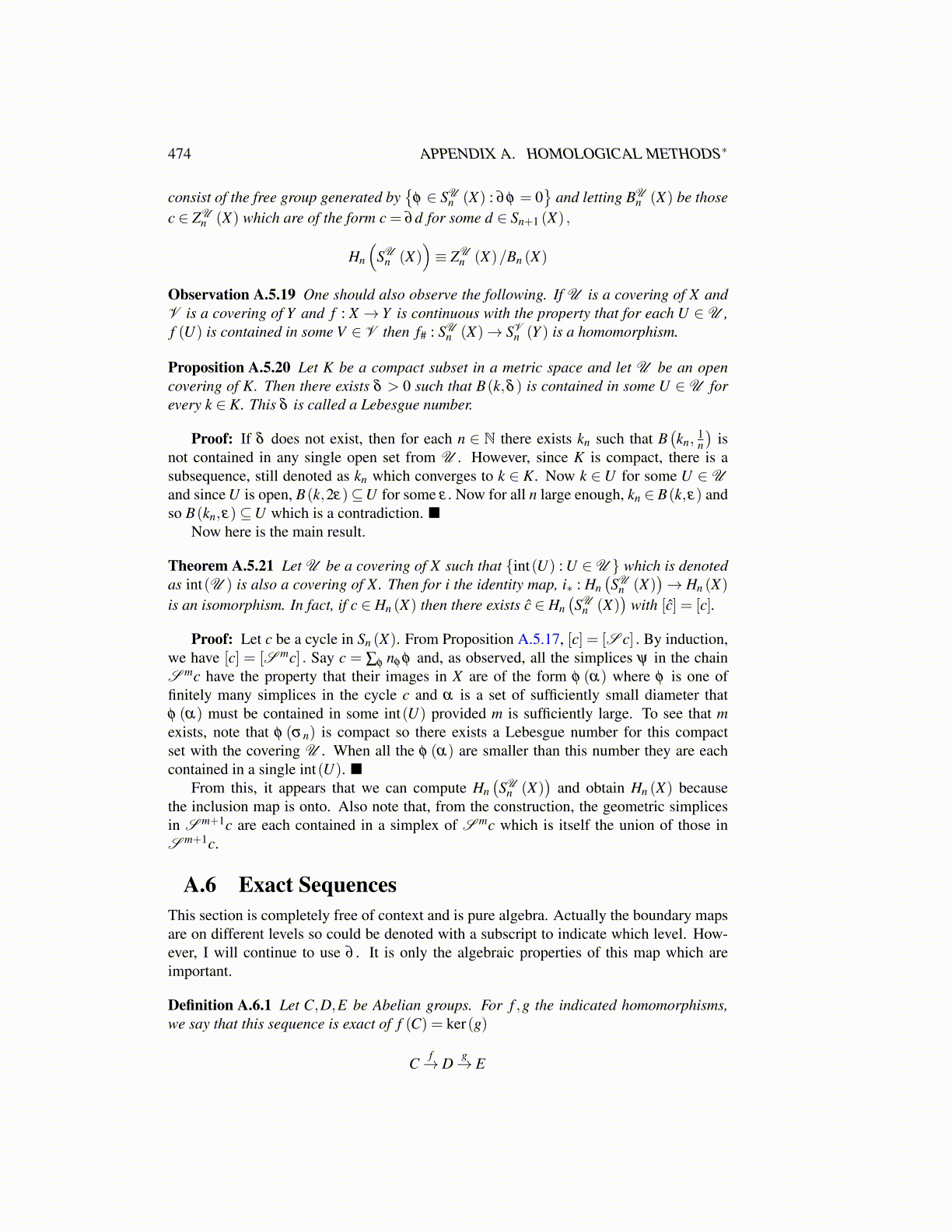
474 APPENDIX A. HOMOLOGICAL METHODS∗
consist of the free group generated by{
φ ∈ SUn (X) : ∂φ = 0
}and letting BU
n (X) be thosec ∈ ZU
n (X) which are of the form c = ∂d for some d ∈ Sn+1 (X) ,
Hn
(SU
n (X))≡ ZU
n (X)/Bn (X)
Observation A.5.19 One should also observe the following. If U is a covering of X andV is a covering of Y and f : X → Y is continuous with the property that for each U ∈U ,f (U) is contained in some V ∈ V then f# : SU
n (X)→ SVn (Y ) is a homomorphism.
Proposition A.5.20 Let K be a compact subset in a metric space and let U be an opencovering of K. Then there exists δ > 0 such that B(k,δ ) is contained in some U ∈ U forevery k ∈ K. This δ is called a Lebesgue number.
Proof: If δ does not exist, then for each n ∈ N there exists kn such that B(kn,
1n
)is
not contained in any single open set from U . However, since K is compact, there is asubsequence, still denoted as kn which converges to k ∈ K. Now k ∈U for some U ∈ Uand since U is open, B(k,2ε)⊆U for some ε. Now for all n large enough, kn ∈ B(k,ε) andso B(kn,ε)⊆U which is a contradiction. ■
Now here is the main result.
Theorem A.5.21 Let U be a covering of X such that {int(U) : U ∈U } which is denotedas int(U ) is also a covering of X. Then for i the identity map, i∗ : Hn
(SU
n (X))→ Hn (X)
is an isomorphism. In fact, if c ∈ Hn (X) then there exists ĉ ∈ Hn(SU
n (X))
with [ĉ] = [c].
Proof: Let c be a cycle in Sn (X). From Proposition A.5.17, [c] = [S c] . By induction,we have [c] = [S mc] . Say c = ∑φ nφ φ and, as observed, all the simplices ψ in the chainS mc have the property that their images in X are of the form φ (α) where φ is one offinitely many simplices in the cycle c and α is a set of sufficiently small diameter thatφ (α) must be contained in some int(U) provided m is sufficiently large. To see that mexists, note that φ (σn) is compact so there exists a Lebesgue number for this compactset with the covering U . When all the φ (α) are smaller than this number they are eachcontained in a single int(U). ■
From this, it appears that we can compute Hn(SU
n (X))
and obtain Hn (X) becausethe inclusion map is onto. Also note that, from the construction, the geometric simplicesin S m+1c are each contained in a simplex of S mc which is itself the union of those inS m+1c.
A.6 Exact SequencesThis section is completely free of context and is pure algebra. Actually the boundary mapsare on different levels so could be denoted with a subscript to indicate which level. How-ever, I will continue to use ∂ . It is only the algebraic properties of this map which areimportant.
Definition A.6.1 Let C,D,E be Abelian groups. For f ,g the indicated homomorphisms,we say that this sequence is exact of f (C) = ker(g)
Cf→ D
g→ E